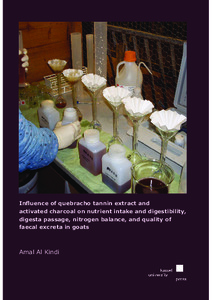| dc.date.accessioned | 2015-06-30T14:08:03Z | |
| dc.date.available | 2015-06-30T14:08:03Z | |
| dc.date.issued | 2015 | |
| dc.identifier.uri | urn:nbn:de:hebis:34-2015063048649 | |
| dc.identifier.uri | http://hdl.handle.net/123456789/2015063048649 | |
| dc.description | Zugl.: Kassel, Univ., Diss. 2015 | |
| dc.language.iso | eng | |
| dc.publisher | kassel university press | ger |
| dc.rights | Urheberrechtlich geschützt | |
| dc.rights.uri | https://rightsstatements.org/page/InC/1.0/ | |
| dc.subject.ddc | 630 | |
| dc.title | Influence of quebracho tannin extract and activated charcoal on nutrient intake and digestibility, digesta passage, nitrogen balance, and quality of faecal excreta in goats | ger |
| dc.type | Dissertation | |
| dcterms.abstract | The current study investigated the possibilities of producing manure that meets the specific requirements of irrigated organic cropping systems under arid sub-tropical conditions.
Therefore, two trials with goats were conducted that investigated the impact of control diets on their digestibility and faecal concentration with the goal to lowerfaecal concentration levels and meet the requirements of irrigated organic cropping.
Feeding ruminants with condensed tannins (CT) will lower ruminal protein degradation, reduce urinary N excretion and might increase the faecal fraction of slowly decomposable N (nitrogen); the inclusion of activated charcoal (AC) into the diet might enrich the animals’ manure with long-lived C (carbon) species to be sequestered in the soil. Such manure might also help reducing emission of greenhouse gases and provide a suitable environment for microbial growth in soil. Microbial biomass in faeces is also expected to change upon AC and CT feeding to ruminants, due to alteration in their digestion processes.
Faecal microbial biomass plays a critical and direct role for the build-up of soil organic matter and the subsequent cycling of C and N.
Feeding up to 3% AC has also the potential to produce manure that meets the specific requirements of irrigated arid sub-tropical cropping systems through its content of long-lived C species and slowly decomposable carbohydrate fractions. In long term this might also help reducing N losses through gaseous emissions or leaching, as slowly decomposable C will help stabilizing soil organic matter. | |
| dcterms.accessRights | open access | |
| dcterms.creator | Al Kindi, Amal | |
| dcterms.extent | 130 Seiten | |
| dc.contributor.corporatename | Kassel, Universität Kassel, Fachbereich Ökologische Agrarwissenschaften | |
| dc.contributor.referee | Schlecht, Eva | |
| dc.contributor.referee | Sundrum, Albert | |
| dc.relation.isbn | 978-3-86219-571-8 | |
| dc.subject.swd | Subtropen | ger |
| dc.subject.swd | Trockengebiet | ger |
| dc.subject.swd | Ziege | ger |
| dc.subject.swd | Futtermittel | ger |
| dc.subject.swd | Stallmist | ger |
| dc.subject.swd | Stickstoffwechsel | ger |
| dc.subject.swd | Kohlenstoffwechsel | ger |
| dc.subject.swd | Biologische Landwirtschaft | ger |
| dc.date.examination | 2015-02-03 | |
| kup.iskup | true | |
| kup.subject | Agrarwissenschaft und Ökologie | |
| kup.typ | Dissertation | |
| kup.binding | Softcover | |
| kup.size | DIN A5 | |

